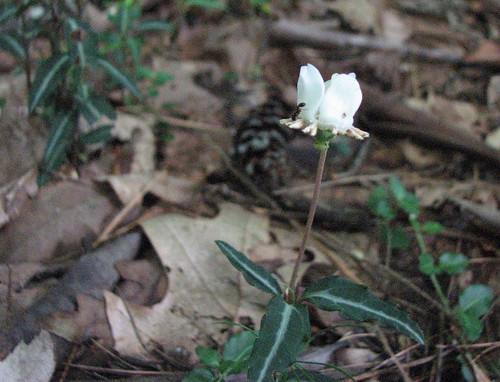How to Identify Spotted Wintergreen/Pipsissewa
One of the evergreen plants I see on my nature hikes lately is spotted wintergreen (Chimaphila maculata). Another of its common names, “pipsissewa”, apparently came from the Cree word “pipisisikewu.”

Photo Caption: Spotted wintergreen is a native flower found in our Appalachian woodlands. Look for its white blooms in the early spring.
Though the root was once used in root beer* recipes, this is a plant usually appreciated for its quiet beauty. The glossy green leaves with their center white stripe are appealing all winter long in spite of its diminutive size.
I was told that the common name came from spots on the flowers since the leaves are clearly striped. They seem solidly white to me, so if anyone can solve this mystery I’d appreciate it.
Other identifying characteristics are a wedge-shaped leaf with toothed edges and violet pollen in the flowers.
I took these flowered photos last May near the Joyce Kilmer Memorial Forest. In the winter they look much the same, without the paler new growth (or blooms). I’ve seen them recently at Caesar’s Head State Park and at Lake Conestee Nature Park.
*Edit 2/14/2010* I’ve heard that the root may not have been used in root beer recipes after all. It is popularly quoted in literature… but it could just be popular to quote it. If anyone has personal experience with using spotted wintergreen in root beer please let me know. Otherwise, I’m going to hypothesize that somewhere along the way it got mixed up with true wintergreen (Gaultheria procumbens).

